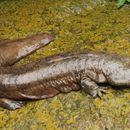Biology
provided by Arkive
This giant amphibian is generally active at night, when it relies on smell and touch to locate its prey. It lives in muddy, dark rock crevices along riverbanks and feeds on fish, smaller salamanders, worms, insects, crayfish and snails, catching them with a rapid sideways snap of the mouth (2) (5).
Like other amphibians, this salamander has smooth skin that lacks scales. The moist skin acts as a respiratory surface, where oxygen enters the body and carbon dioxide is released (4).
Mating behaviour has been described for the Japanese giant salamander (Andrias japonicus) and is probably similar for the Chinese giant salamander (4). Reproduction appears to take place from late August to September, when hundreds of individuals congregate at nest sites (4) (6). Males occupy breeding cavities which are aggressively guarded against intruders (6). Males compete viciously, with many dying from injuries (6). Females enter the cavities, lay between 400 and 500 eggs that are held together like a thread of beads and then leave immediately (4) (6). The male fertilises the eggs, and protect them from predators such as fish, until they hatch 12 to 15 weeks later in the early spring (4) (7). The larvae are only three centimetres long and resemble adults in shape. As larvae they do have gills, and though they lose them quite early in life, they never fully lose all larval characteristics. Both the Chinese and Japanese giant salamanders are long lived, with one specimen in captivity living for 52 years (4).
Conservation
provided by Arkive
The Chinese giant salamander is now protected from international trade by its listing on Appendix I of the Convention of International Trade of Endangered Species (CITES) (3). Since the 1980s, 14 nature reserves, with a total area of more than 355,000 hectares, have been established for the conservation of the Chinese giant salamander (7). This includes the a huge 99,975 hectare area of Mount Wuyi, China was designated as a World Heritage Site in 1999, dedicated to conserving this biodiverse region, including the habitat of this salamander (8). The surrounding area has a growing population and the establishment of this reserve will protect many species. However, there are still concerns that development around the reserve, and tourism plans within the reserve will place pressure on Mount Wuyi's rich resources, healthy rivers and habitats. Conservation efforts to protect this habitat and other areas where the ancient Chinese giant salamander is found are essential for the survival of this species and many others (8).
Description
provided by Arkive
The Chinese giant salamander is the largest salamander in the world, and is fully aquatic, with many adaptations for this lifestyle. It grows up to 1.8 metres in length, though most individuals found today are considerably smaller (2). The skin is dark brown, black or greenish in colour and irregularly blotched. It is also rough, wrinkled and porous which facilitates respiration through the skin as this large amphibian lacks gills (4). This species has an elongated body, and two pairs of legs which are roughly similar in size. The snout is less rounded than that of the related Japanese giant salamander and the tail is a little longer and broader. Both species have tubercles on the head and throat, though their arrangement is different. The Chinese species has small, paired tubercles arranged in rows parallel with the lower jaw, while the Japanese species' tubercles are mostly single and irregularly scattered (4). The eyes are tiny, with no eyelids, and positioned on top of the broad, flat head, providing the salamander with poor vision (5).
Habitat
provided by Arkive
The Chinese giant salamander inhabits cold, fast running mountain streams and lakes, occupying hollows and cavities under water (4).
Range
provided by Arkive
This species occurs in the mountain streams of China, below 1,500 metres above sea level in the tributaries of the Pearl, Yellow and Yangtze Rivers (4).
Status
provided by Arkive
Classified as Critically Endangered (CR) on the IUCN Red List 2007 (1), and listed on Appendix I of CITES (3).
Threats
provided by Arkive
This species is threatened by hunting, as its flesh is considered a delicacy in Asia. Other threats include habitat alteration and loss; deforestation causes soil erosion and increased runoff and silting in rivers. The building of dams in China over the years has also changed the natural river flow in some areas where the Chinese giant salamander is found. Local pesticides, fertilizers and pollutants are also thought to affect the health of this amphibian, though little research has been conducted. Symptoms of these recent threats include the lower numbers of Chinese giant salamander recorded, smaller populations and also smaller individuals (4).

